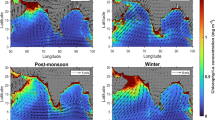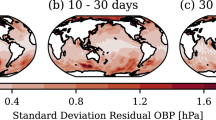Abstract
Satellite-derived phytoplankton pigment absorption (a ph) has been used as a key predictor of phytoplankton photosynthetic efficiency to estimate global ocean net primary production (NPP). In this study, an a ph-based NPP model (AbPM) with four input parameters including the photosynthetically available radiation (PAR), diffuse attenuation at 490 nm (K d(490)), euphotic zone depth (Z eu) and the phytoplankton pigment absorption coefficient (a ph) is compared with the chlorophyll-based model and carbon-based model. It is found that the AbPM has significant advantages on the ocean NPP estimation compared with the chlorophyll-based model and carbonbased model. For example, AbPM greatly outperformed the other two models at most monitoring sites and had the best accuracy, including the smallest values of RMSD and bias for the NPP estimate, and the best correlation between the observations and the modeled NPPs. In order to ensure the robustness of the model, the uncertainty in NPP estimates of the AbPM was assessed using a Monte Carlo simulation. At first, the frequency histograms of simple difference (δ), and logarithmic difference (δ LOG) between model estimates and in situ data confirm that the two input parameters (Z eu and PAR) approximate the Normal Distribution, and another two input parameters (a ph and K d(490)) approximate the logarithmic Normal Distribution. Second, the uncertainty in NPP estimates in the AbPM was assessed by using the Monte Carlo simulation. Here both the PB (percentage bias), defined as the ratio of ΔNPP to the retrieved NPP, and the CV (coefficient of variation), defined as the ratio of the standard deviation to the mean are used to indicate the uncertainty in the NPP brought by input parameter to AbPM model. The uncertainty related to magnitude is denoted by PB and the uncertainty related to scatter range is denoted by CV. Our investigations demonstrate that PB of NPP uncertainty brought by all parameters with an annual mean of 5.5% covered a range of–5%–15% for the global ocean. The PB uncertainty of AbPM model was mainly caused by a ph; the PB of NPP uncertainty brought by a ph had an annual mean of 4.1% for the global ocean. The CV brought by all the parameters with an annual mean of 105% covered a range of 98%–134% for global ocean. For the coastal zone of Antarctica with higher productivity, the PB and CV of NPP uncertainty brought by all parameters had annual means of 7.1% and 121%, respectively, which are significantly larger than those obtained in the global ocean. This study suggests that the NPPs estimated by AbPM model are more accurate than others, but the magnitude and scatter range of NPP errors brought by input parameter to AbPM model could not be neglected, especially in the coastal area with high productivity. So the improving accuracy of satellite retrieval of input parameters should be necessary. The investigation also confirmed that the SST related correction is effective for improving the model accuracy in low temperature condition.
Similar content being viewed by others
References
Antoine D, Morel A. 1996. Oceanic primary production: 1. Adaptation of a spectral light-photosynthesis model in view of application to satellite chlorophyll observations. Global Biogeochemical Cycles, 10(1): 43–55
Austin R W, Petzold T J. 1986. Spectral dependence of the diffuse attenuation coefficient of light in ocean waters. Optical Engineering, 25(3): 253471
Behrenfeld M J, Falkowski P G. 1997. A consumer’s guide to phytoplankton primary productivity models. Limnology and Oceanography, 42(7): 1479–1491
Behrenfeld M J, Randerson J T, McClain C R, et al. 2001. Biospheric primary production during an ENSO transition. Science, 291(5513): 2594–2597
Bianchi A A, Bianucci L, Piola A R, et al. 2005. Vertical stratification and air-sea CO2 fluxes in the Patagonian shelf. Journal of Geophysical Research, 110(C7), doi: 10.1029/2004JC002488
Carr M E, Friedrichs M A M, Schmeltz M, et al. 2006. A comparison of global estimates of marine primary production from ocean color. Deep Sea Research Part II—Topical Studies in Oceanography, 53(5–7): 741–770
Eppley R W. 1972. Temperature and phytoplankton growth in the sea. Fishery Bulletin, 70: 1063–1086
Falkowski P G, Barber R T, Smetacek V. 1998. Biogeochemical controls and feedbacks on ocean primary production. Science, 281(5374): 200–206
Friedrichs M A M, Carr M E, Barber R T, et al. 2009. Assessing the uncertainties of model estimates of primary productivity in the tropical Pacific Ocean. Journal of Marine Systems, 76(1–2): 113–133
Garcia H E, Locarnini R A, Boyer T P, et al. 2010. World ocean atlas 2009, volume 4: nutrients (phosphate, nitrate, silicate). In: Levitus S, ed. NOAA Atlas NESDIS 71. Washington, DC: US Government Printing Office, 398
Gordon H R, Clark D K. 1980. Remote sensing optical properties of a stratified ocean: an improved interpretation. Applied Optics, 19(20): 3428–3430
Hirawake T, Takao S, Horimoto N, et al. 2011. A phytoplankton absorption- based primary productivity model for remote sensing in the Southern Ocean. Polar Biology, 34(2): 291–302
Hiscock M R, Lance V P, Apprill A M, et al. 2008. Photosynthetic maximum quantum yield increases are an essential component of the Southern Ocean phytoplankton response to iron. Proceedings of the National Academy of Sciences of the United States of America, 105(12): 4775–4780
Kiefer D A, Cullen J J. 1991. Phytoplankton growth and light absorption as regulated by light, temperature, and nutrients. Polar Research, 10(1): 163–172
Kishi M J, Kashiwai M, Ware D M, et al. 2007. NEMURO—a lower trophic level model for the North Pacific marine ecosystem. Ecological Modelling, 202(1–2): 12–25
Lee Z, Lance V P, Shang Shaoling, et al. 2011. An assessment of optical properties and primary production derived from remote sensing in the Southern Ocean (SO GasEx). Journal of Geophysical Research, 116(C4): doi: 10.1029/2010JC006747
Lee Z P, Carder K L. 2004. Absorption spectrum of phytoplankton pigments derived from hyperspectral remote-sensing reflectance. Remote Sensing of Environment, 89(3): 361–368
Lee Z P, Carder K L, Marra J, et al. 1996. Estimating primary production at depth from remote sensing. Applied Optics, 35(3): 463–474
Longhurst A, Sathyendranath S, Platt T, et al. 1995. An estimate of global primary production in the ocean from satellite radiometer data. Journal of Plankton Research, 17(6): 1245–1271
Ma Sheng, Tao Zui, Yang Xiaofeng, et al. 2014. Estimation of marine primary productivity from satellite-derived phytoplankton absorption data. IEEE Journal of Selected Topics in Applied Earth Observations and Remote Sensing, 7(7): 3084–3092
Marañón E, Cermeño P, Latasa M, et al. 2012. Temperature, resources, and phytoplankton size structure in the ocean. Limnology and Oceanography, 57(5): 1266–1278
Marra J, Ho C, Trees C C. 2003. An alternative algorithm for the calculation of primary productivity from remote sensing data. LDEO Technical Report # LDEO-2003–1. Grant: National Aeronautics and Space Administration
Marra J, Trees C C, O’Reilly J E. 2007. Phytoplankton pigment absorption: a strong predictor of primary productivity in the surface ocean. Deep Sea Research Part I—Oceanographic Research Papers, 54(2): 155–163
McClain C R, Cleave M L, Feldman G C, et al. 1998. Science quality Sea WiFS data for global biosphere research. Sea Technology, 39(9): 10–15
Medina-Gómez I, Herrera-Silveira J A. 2006. Primary production dynamics in a pristine groundwater influenced coastal lagoon of the Yucatan Peninsula. Continental Shelf Research, 26(8): 971–986
Milutinovic S, Behrenfeld M J, Johannessen J A, et al. 2009. Sensitivity of remote sensing-derived phytoplankton productivity to mixed layer depth: lessons from the carbon-based productivity model. Global Biogeochemical Cycles, 23(4): doi: 10.1029/2008GB003431
Milutinovic S, Bertino L. 2011. Assessment and propagation of uncertainties in input terms through an ocean-color-based model of primary productivity. Remote Sensing of Environment, 115(8): 1906–1917
Morel A, Maritorena S. 2001. Bio-optical properties of oceanic waters: a reappraisal. Journal of Geophysical Research, 106(C4): 7163–7180
Muller-Karger F, Varela R, Thunell R, et al. 2001. Annual cycle of primary production in the Cariaco Basin: response to upwelling and implications for vertical export. Journal of Geophysical Research, 106(C3): 4527–4542
Ondrusek M E, Bidigare R R, Waters K, et al. 2001. A predictive model for estimating rates of primary production in the subtropical North Pacific Ocean. Deep Sea Research Part II—Topical Studies in Oceanography, 48(8–9): 1837–1863
Platt T, Sathyendranath S. 1993. Estimators of primary production for interpretation of remotely sensed data on ocean color. Journal of Geophysical Research, 98(C8): 14561–14576
Reay D S, Priddle J, Nedwell D B, et al. 2001. Regulation by low temperature of phytoplankton growth and nutrient uptake in the Southern Ocean. Marine Ecology Progress Series, 219: 51–64
Ricchiazzi P, Yang Shiren, Gautier C, et al. 1998. SBDART: a research and teaching software tool for plane-parallel radiative transfer in the Earth’s atmosphere. Bulletin of the American Meteorological Society, 79(10): 2101–2114
Saba V S, Friedrichs M A M, Antoine D, et al. 2011. An evaluation of ocean color model estimates of marine primary productivity in coastal and pelagic regions across the globe. Biogeosciences, 8(2): 489–503
Saba V S, Friedrichs M A M, Carr M E, et al. 2010. Challenges of modeling depth-integrated marine primary productivity over multiple decades: a case study at BATS and HOT. Global Biogeochemical Cycles, 24(3): doi: 10.1029/2009GB003655
Siegel D A, Westberry T K, O’Brien M C, et al. 2001. Bio-optical modeling of primary production on regional scales: the Bermuda BioOptics project. Deep Sea Research Part II—Topical Studies in Oceanography, 48(8–9): 1865–1896
Sunda W G, Huntsman S A. 1997. Interrelated influence of iron, light and cell size on marine phytoplankton growth. Nature, 390(6658): 389–392
Uitz J, Huot Y, Bruyant F, et al. 2008. Relating phytoplankton photophysiological properties to community structure on large scales. Limnology and Oceanography, 53(2): 614–630
Westberry T, Behrenfeld M J, Siegel D A, et al. 2008. Carbon-based primary productivity modeling with vertically resolved photoacclimation. Global Biogeochemical Cycles, 22(2): doi: 10.1029/2007GB003078
Woźniak B, Ficek D, Ostrowska M, et al. 2007. Quantum yield of photosynthesis in the Baltic: a new mathematical expression for remote sensing applications. Oceanologia, 49(4): 527–542
Acknowledgements
We thank the organizations for free data providing. The MODIS ocean color productions and in situ data of phytoplankton pigment absorption were downloaded from NASA Ocean Color websites (http://oceancolor.gsfc.nasa.gov/). The in situ NPP data were downloaded from the website of Hawaii Ocean Time-series program (http://hahana.soest.hawaii.edu/hot/), Bermuda Atlantic Time-series Study (http://bats.bios.edu/), California Cooperative Oceanic Fisheries Investigations (http://www.calcofi.org/), Biological and Chemical Oceanography Data Management Office (http://www.bco-dmo.org/), Palmer Station Long-Term Ecological Research (http://pal.lternet. edu/data/) and Atmospheric Dynamics and Fluxes in the Mediterranean Sea (http://www.obs-vlfr.fr/cd_rom_dmtt/dyf_main.htm).
Author information
Authors and Affiliations
Corresponding author
Additional information
Foundation item: The National Natural Science Fundation of China under contract No. 41501389; the Foundation of State Key Laboratory of Remote Sensing Science in China under contract No. OFSLRSS201509.
Rights and permissions
About this article
Cite this article
Tao, Z., Ma, S., Yang, X. et al. Assessing the uncertainties of phytoplankton absorption-based model estimates of marine net primary productivity. Acta Oceanol. Sin. 36, 112–121 (2017). https://doi.org/10.1007/s13131-017-1047-8
Received:
Accepted:
Published:
Issue Date:
DOI: https://doi.org/10.1007/s13131-017-1047-8




